Space Shuttle Launch Complex 39-B Construction Photos
Page 14
PGHM Bridge Beam Lift, Page 3
(Original Scan)
This is the point at which you should be stopping and considering the skill of not just the ironworkers, but also the crane operator. He's got the boom of his crane up into a confined space with almost zero clearance to work, cannot see his load, and yet somehow is managing to articulate things that weigh more than your house with the skill and finesse of a surgeon.
Amazing!
And the ironworkers are trusting this man with their lives at every moment. One misstep, and the results would be catastrophic. (Someday I'll tell you about what happened when we cut the eighty-foot-tall UES Door loose from its hinges, up in the air on the MST, out at Complex 41, but not today.)
I cannot say enough about the skill, the integrity, the intelligence, and the commitment of the people in these pictures. If you weren't around to witness it in person, it's impossible to appreciate, or even imagine, what went down out on the Pad.
Additional commentary below the image.
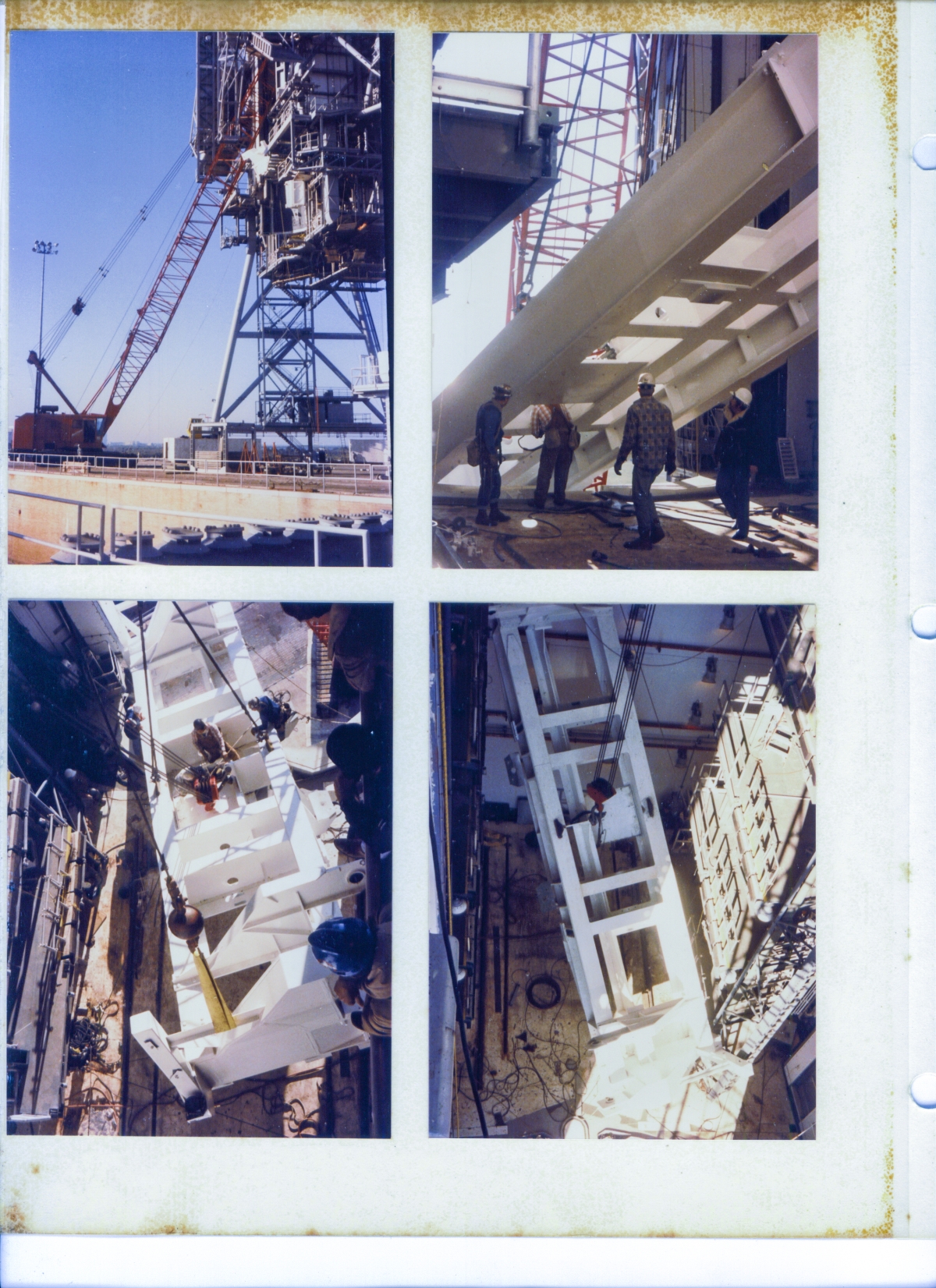
Top Left: (Full-size)
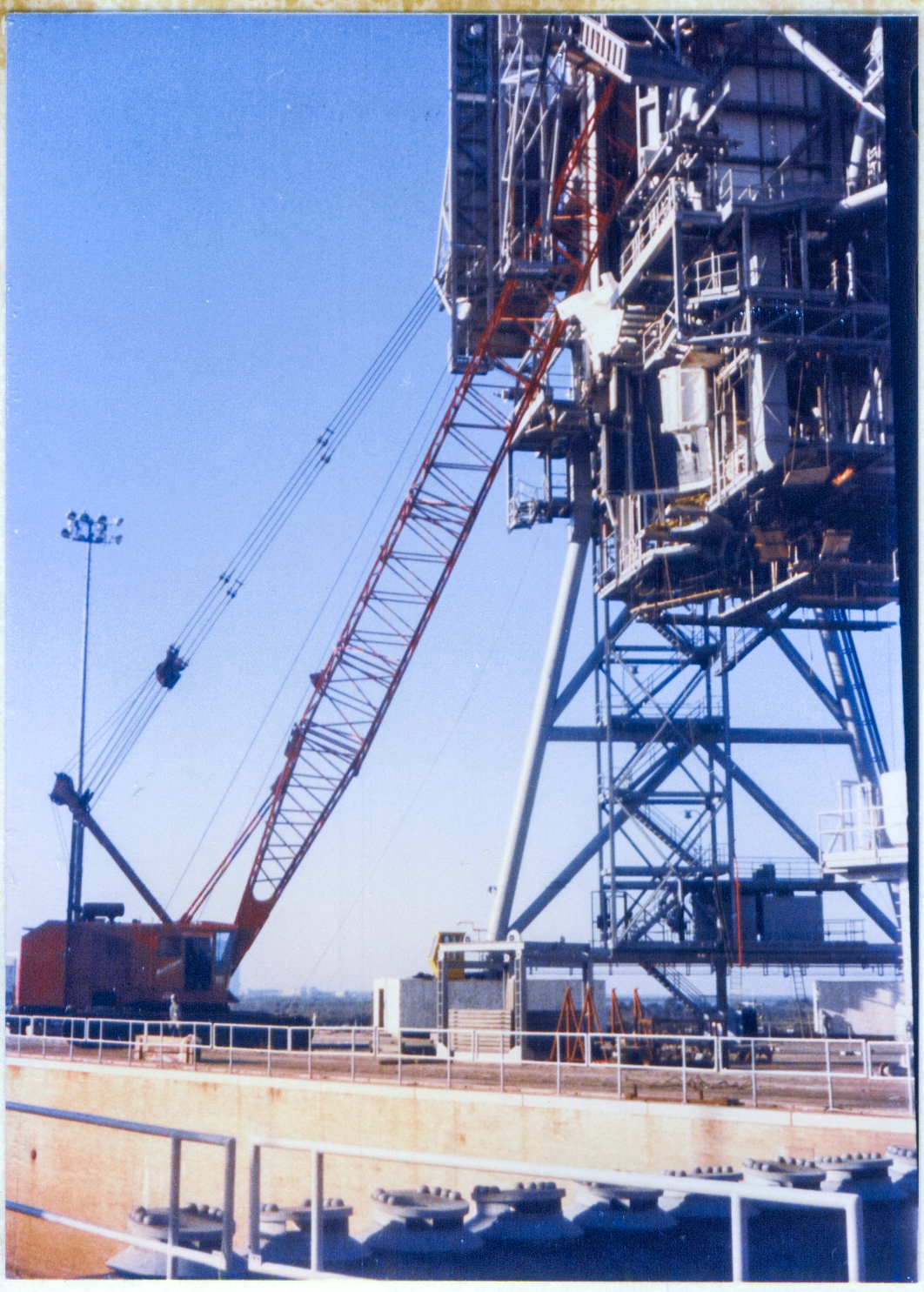
And now I've walked farther north along the east side of the flame trench, all the way past the flame deflector, the SSW spray headers of which, running along its crest, can be seen down in the very bottom, right, of the image.
This position locates me near-parallel with the face of the RSS, and I've taken it to show you not only that the bridge beam is now almost completely swallowed into the depths of the PCR, but that the end of the main boom, and all of the jib is too!
Our crane operator (goddamnit I wish I could remember his name but alas, I cannot), is doing some extraordinary things here, the like of which most people never get to see in their entire lives.
That crane boom is big, and it's massive and it's not like you're maneuvering a fork around on your plate going after the last of the peas, or something.
This is real shit.
The physical dynamics of a crane boom that size, coupled with a load that it's hooked on to twice, in two different places, in conjunction with the inertia and physical envelope of that massive load it's bearing as well as the stresses being invisibly applied to that load by our gang of ironworkers attaching and applying forces to it with their own rigging inside the PCR here and there, now and again, first this way then that, beggar the imagination. With each movement and adjustment, the boom flexes and recenters itself, the wire ropes holding the hooks go momentarily off-center and then recenter, sometimes in pendulum fashion, and the tensions on all of the lines rise and fall with rhythms and harmonies all their own. The crane operator can't see a fucking thing, and yet somehow the boom never touches any of its suffocatingly-claustrophobic iron surroundings and the load stays or goes, hovers or travels, rises or falls, twists and turns, and all of the rest of it, with a level of precision down to and including sub-inch nuances. Gah.... why am I even trying here? Nobody's going to understand any of this. It's impossible.
And yet, against a waterfall of vacant-eyed "Uh huh, yeah," coming from all around me, I shall persist.
A verbal illustration perhaps.
From a different time.
With a different crane.
I was working for Sheffield Steel.
Not this job, but this same launch pad.
The crane operator was working for Wilhoit and his name was "Nobel" and that much I can recall, but the spelling of his name may well be off.
Same-sized great goddamned big red Manitowoc, with just as much stick, or even more perhaps, than the crane in these pictures.
And I was up there on the pad deck, underneath the RSS over on the Column Line 7 side of things, and Nobel was in his cab, parked out in front of the RSS in a similar position as where the crane in this image is parked, but with the boom facing the other way, facing toward the east, and nothing was going on for him at the moment while the ironworkers were blazing away at god-knows-what somewhere in the sky up above us, and he had some free time on his hands.
And it took me a minute before what was going on in the corner of my eye properly registered, at which point I dumbfoundedly stopped everything I was doing gave it my full and complete attention.
Nobel had the boom at a pretty high angle, and the headache ball hanging from the end of the jib on the whip line was just about eye-level with him as he sat in the cab, and he was doing repetitions. He was performing a little arrangement with his crane like a musician repeating scales or perhaps some little riff, over and over.
And he'd have everything in equilibrium, with the headache ball suspended, still and motionless, right there in front of him.
And then, and remember now, the guy was just playing around, just amusing himself, just passing the time, he'd smartly boom left, rotating the crane cab and boom (which we cannot forget is somewhere around 200 feet in length) in a counterclockwise direction, causing the boom to travel from the right toward the left, and of course the tip of the jib would initially get way the hell out in front of the headache ball, and physics would belatedly instruct the ball, "Hey! Get over there! You're not directly beneath the sheave that's supporting you anymore," and the line, and the ball, would both start swinging across to the side, right to left, as a pendulum swings.
Nobel still working the crane, still swinging the boom right to left, out over the flame trench.
At which point he'd suddenly reverse the direction he was booming the crane, rotating the crane cab and boom in the opposite direction and would now be booming, left to right.
But only briefly.
And then stop that rotation, recenter the boom and come to a complete halt, no rotation in either direction, crane cab perfectly still, once again.
And while he worked the boom, the ball, and the line it was suspended from, both continued to reposition themselves, still traveling in the original direction they started with. Still traveling right to left.
Until the headache ball got to exactly where Nobel had originally wanted it to go in the first place, stopping dead without any further pendulum motion.
Just... stop.
On a dime.
The ball would swing to the side from right to left, get to where Nobel wanted it, and then cease all movement.
No pendulum action of any kind.
Line dead-straight, ball dead still.
In one smooth motion.
Go try this for yourself, maybe. With a yo-yo on a long string or something.
Swing that fucker to the side, and then, as the yo-yo starts moving to the side, correct, and then stop your swing, in a way that causes the yo-yo to come to a smooth stop in its new location without any further swinging from side-to-side. Without any further pendulum motion.
And I'm guessing you won't be able to do it.
With a fucking piece of string and a goddamned child's toy on the end of it.
Now go get yourself a nice full-size construction crane. Put a couple of hundred feet of boom on it.
Now do it with that.
Yeah.
Top Right:
(Full-size)
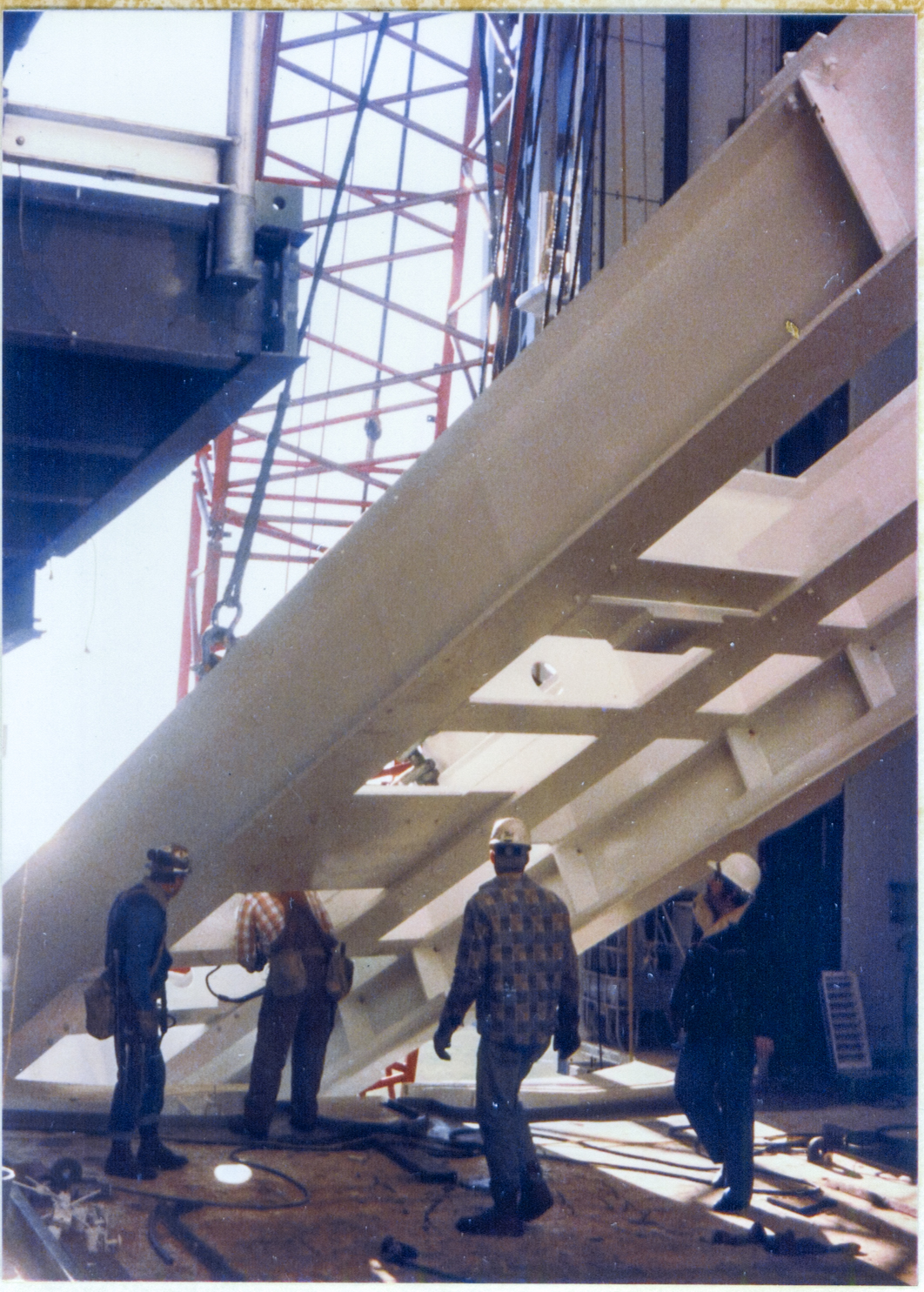
And now I've finally departed the pad deck, gone up the FSS elevator and out across the catwalk onto the RSS at the 135' level, into the PCR, and I'm now standing as far back in the left side of the PCR as I can get with an unobstructed view, to try and capture as wide an angle as possible, to show where we are right now, but really, this photograph is a woefully inadequate thing.
In the top left of the frame, the very back corner of level 1 of the left-hand PCR interior platform set can be seen, complete with just a bit of its removable handrail (Aluminum, because it's lighter, and inside a place like the PCR, where multi-hundred million dollar objects are frightfully close at hand sometimes, we're going to need all the help we can get when it comes to making things that have to be moved around as light as possible so as to reduce the risk of, god forbid, dropping them.) set down into its support socket on the perimeter platform framing member.
Our bridge beam is now plainly visible as being just as large and massive as it really is, looming overhead and going right on out of the frame in both directions.
Take careful note of how that bridge beam goes out of view behind the top edge of the OMS Pod Heated Purge Cover down near the bottom edge of the frame. There are two OMS Pod Heated Purge Covers, one on each side with a bit of a gap between them, and the bridge beam is disappearing over the edge of the pod cover on the left side of the image, and the cover plate for the notch in the RSS 135'-level floor plate, which accommodated the base of the orbiter's tail, between them. For reference, in order to help you orient yourself with the complexity of the decking in this area, our ironworker who is standing with his head inside of the bridge beam, obscured from view, is standing on the very edge of the 135'-level deckplate, with his right shoe nearly resting against the cover plate for the notch, and the toe of his left shoe at the edge of the deck plate adjacent to the right edge, of the left OMS Pod heated purge cover. This is where we are, ok?
Things are not as they appear.
The top edge of the pod cover looks for all the world like the edge of the PCR floor steel, but it is not. It is not only not part of the floor steel, it is not even steel. It's aluminum. The floor steel starts back inboard from the edge you seen in this frame, a couple of feet in the direction of the ironworkers who are riding herd on this lift.
The OMS Pod heated purge covers are flimsiness incarnate and were fabricated off site, by a specialty concern having a shop that could deal with their peculiarities, most of which stemmed from their having been constructed of aluminum. Aluminum is a bitch to weld, and will warp, or crack, or warp and crack, at the slightest provocation, down to and including the mere look on your face as you weld the stuff. And the pod covers were weldments, and weldments with a lot of closely-spaced bracing welded on to their opposite sides, away from the side that faced the OMS Pods, to keep them nice and stiff, and to prevent them from flexing or bending, even just the weenciest little bit, or otherwise they might bang into the OMS Pods and break the Space Shuttle (not recommended), and this made them very very difficult to fabricate anywhere, and impossible to fabricate in the field.
Thanks, engineer-guys, for spec'ing out something that looked so neat and well-organized on your goddamned drawing of it, but which was in fact a nightmare, jointly and severally, out in the real world, which I presume you people have never actually visited in your entire lives.
Aluminum is nice and light, and in this instance light was the determining factor in their choice of materials since the stupid things were designed and built as an afterthought, well after the orbiter-side perimeter framing steel for the PCR floor, down at the 135 level of the RSS, had been designed, fabricated, erected, and then redesigned, cut back, and reinstalled to accommodate their useless asses. That entire system of floor-framing steel was never intended to act as a load-bearing element of the RSS. It's the fucking floor after all, and its whole purpose in life was to hold up the deckplates that the floor consisted of, plus whatever loads those deckplates might be expected to carry, which were pretty insubstantial, all things being considered. Techs walking around. Perhaps an equipment cart or two. But nothing heavy. The PGHM was there for that, and now that you've got yourself a nice look at the bridge beam, you can perhaps now imagine what heavy really means in this context.
So ok, so we'll make the fucking pod covers out of nice light aluminum, which is flimsy as all fuck, compared to steel, no matter how much you brace it, and we won't overload the floor with something much heavier, that'll be that.
Except that it's not.
The covers were not only light but they were also never intended to carry any load above and beyond their own flimsy weight and were installed on the floor steel of the PCR in a nasty way.
Haunches were fabricated and welded to the floor framing in two places for the pod cover on either side of the RSS centerline, and these haunches were weird. I'm pretty sure we'll get a look at one of them from the underside here later on in this series of pictures, but for now I shall just describe them as being common light-steel weldments with an uncommon upper surface. That surface was maybe a foot or two across, irregularly-shaped, level and horizontal, and it was actually left bare with some sort of coating which was, horrors, not something from our old nemesis KSC-STD-C-0001, that let you see the nice smooth shiny metal, right on through it.
Why?
Because the stupid pod covers had a matching pair of surfaces for each haunch, also nice and smooth, but this time covered with a Teflon pad, facing downward, and the goddamned things literally hung, in suspension, and in no wise firmly fixed or attached to anything, balanced by their centers of gravity and nothing else, on top of those psychotically ill-designed haunches welded to the PCR floor steel.
Are you still with me here?
If not, stop. Go back. Read that stuff up there again, and keep reading it again until you understand and can visualize the state of these miserable OMS Pod heated purge covers, and the criminally-dangerous "support" structure they were solely supported by.
The pod covers were manifestly stupid, but they were also cunning. And, now that I think about it, I have encountered far too many people in my life, who qualify in the exact same way.
The pod covers were adjustable (isn't everything out here?), and they could be moved this way or that, teflon bearing-pad sliding across the flat top-surface of the haunch, via a crazed system of heavy steel turnbuckles (again, I'm pretty sure we'll get an actual look at things, later on, but not now) attached to aluminum lug plates that were welded to the rest of the all-aluminum pod cover, and which turnbuckles would be manually and laboriously turned, working the threaded rods that made up the business ends of the turnbuckles, farther in or farther out, as the dictates of the orbiter's exact precise position as parked on the MLP (yeah, the MLP too, was something that varied a little bit in its final position, and moved around some, and did not stay in the exact same place every time they rolled the stack out to the pad and set it down on its support pedestals) might require, to allow the evil pod covers to wind up very close to, but never quite touching, the absurdly-delicate thermal protection tiles that covered the orbiter's OMS Pods.
All this cunningness resulted in a painted, (of course!) aluminum upper surface that could not be distinguished in the slightest degree from all that nice solid iron (also hidden beneath a coat of paint) that surrounded it everywhere, and which everyone very reasonably presumed made up and constituted anything and everything that might serve as a surface upon which, things (people perhaps?) might find themselves supported.
Go look at the damn picture again. Zoom it in. Zoom it in just as far as you fucking want to.
Can you tell that's aluminum?
Didn't think so.
Ok.
So now, hopefully, I've got you thinking of steel versus aluminum. Thinking of knife blades versus warm sticks of butter, perhaps.
Which, finally, brings us back to things not being as they appear. Twice.
First, your initial glance at this image might give you to believe that the bridge beam could be supported or maybe just steadied a little bit by resting it against the edge of what appears to be the RSS floor steel, but is in fact the soft yielding aluminum top of the OMS Pod heated purge covers, and second, even though it looks like it is, it is not, which means our crane operator, who, remember, is unable to even see any of this at all, has somehow maneuvered that goddamned hulking nightmare of a PGHM Bridge Beam into a position that is so finely adjusted, and so fucking close to the edge of the pod cover, that you can't even tell it's not actually touching the sonofabitch.
Holy shit! This is beyond impressive. This is fucking miraculous. And yet there it is, right there in front of you.
Bottom Left:
(Full-size)
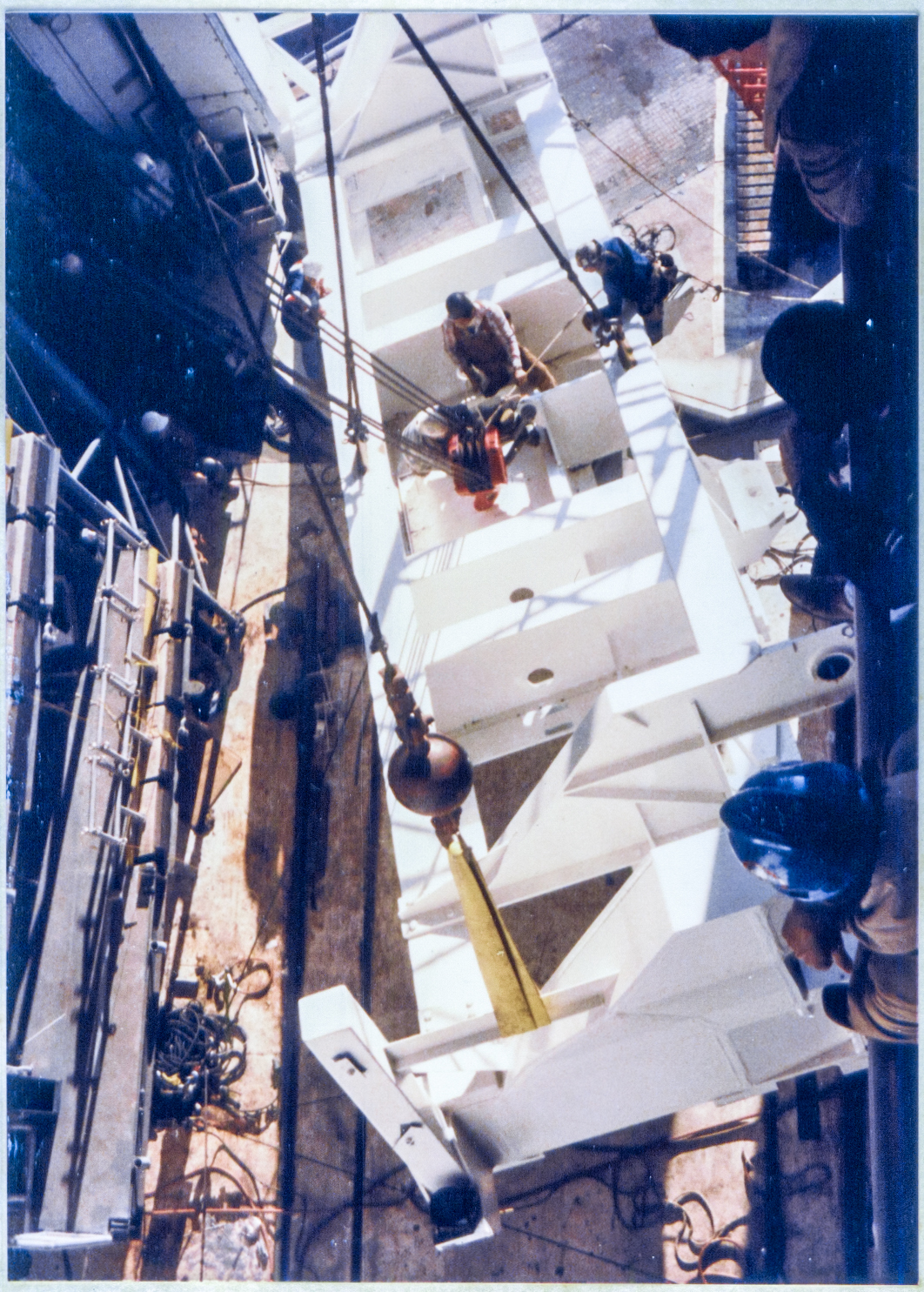
And now I've gone on over to the other side of the PCR and walked up to level five of the right-hand interior platform set, and I'm looking straight down. Three ironworkers are directly below me, on level four, and when you zoom in and look close, you can see that the middle guy has ever-so-casually got his boot on the "ear" of the bridge beam where it extends out past the hole in it that will take the shaft for the bogie that will roll along its support rail, which it will be suspended from once it's properly in place and installed. He might just be resting his foot on it, but he also just might be using his boot to keep the damn thing from drifting into the platform set and either smashing something all to hell, or perhaps stealthily repositioning itself in a way that will cause it to hang up on something and fuck what they're doing with it all up. No way to tell, and I sure as hell do not remember.
Over the bridge beam itself, there's a lifting block and hook being rigged, and it's not the load line on the Manitowoc, which is out of frame, up above.
And now we've finally found the lifting block from the small crane that we saw hiding behind the bridge beam in the first page of images of this lift. And it's going to be carrying the full weight of the bridge beam here pretty soon, and our ironworkers are in the process of hooking on to a shackle near the center, and the center of gravity, of the bridge beam. Once that's been hooked on, the two-part sling under the main hoist block of the Manitowoc can be removed, which will be necessary to back the crane boom far enough out of the way to give them enough clearance overhead to pull the bridge beam up, just under the PCR ceiling, where it's eventually going. They're going to be keeping the jib line attached for a little longer, but the jib is much smaller and more maneuverable in tight spaces, so there's less worries, for the time being anyway, about clearance overhead.
They tell you to never stand under suspended loads, and they're right. Standing under suspended loads is a great way to get yourself killed, and anybody at all who's spent any amount of time at all around this kind of stuff has stories.
But sometimes you have to break your own laws, and today is one of those days. Give these images a look, all of them, and you can see that not only are these guys putting their lives on the line standing underneath a suspended load, they're also standing on top of it, and even inside of it.
The level of trust in here is just about equal to the level of expertise, on everyone's part, and those levels are so far above and beyond anything most people have ever dealt with in their entire lives as to be laughable. We're operating at a level here where there are consequences. Real consequences. Fuck up, and you die. Fuck up, and your buddy dies. And if your buddy fucks up, it's exactly the same. It's exactly the same for everybody. Things have been reduced to their most simple, most elemental nature, and it's strictly a pass or fail test. I sometimes hear everyday people in everyday situations bitching and whining about how bad this thing is, or that thing is. Bitching about just how bad they've got it. And sometimes it's hard to keep from laughing right in their faces. These fucks do not know. Not only that, they're never going to know. And it's probably a good thing, too. Because, no matter how high and mighty they are, no matter how much money they have, no matter how shiny their stupid car is, they're all still a bunch of fuckups. And since they're fuckups, it's best that they never enter an arena such as this one. Because if they did, they'd find a way to fuck it up. And somebody would get killed.
And no, we're not quite done yet with ratcheting things up. Zoom on in. Have a look at the ironworker hanging over the right-hand side of the bridge beam, outboard of the top of the miserable OMS pod heated purge cover, and then look to the right of him and you'll see one of the treads on the big Manitowoc that's over a hundred vertical feet down from where this picture was taken, sitting on the pad deck below, as well as just the teenciest little bit of red crane boom, too. They've put something underneath the crane to protect the concrete of the pad deck, which means the crane has been moving around during this little operation, and that should, but might not, cause you to realize the crane operator is working without his outriggers, which of course are nowhere to be seen. Yeah. Just that much less by way of a solid foundation to pick this goddamned PGHM bridge beam up off the ground and then work it up and inside of the fucked up PCR, feeling his way along like a thief working a lock pick up and inside of a lock, or something. Of course, so long as the thief does not get caught by somebody, the only penalty for doing it wrong is a lock that stays locked. The penalty for turning a large crane over, that's carrying a substantial load, surrounded in claustrophobicly-cramped quarters by a whole crew of ironworkers, is just a weency bit more serious. These people are not fucking around with this one.
Bottom Right:
(Full-size)
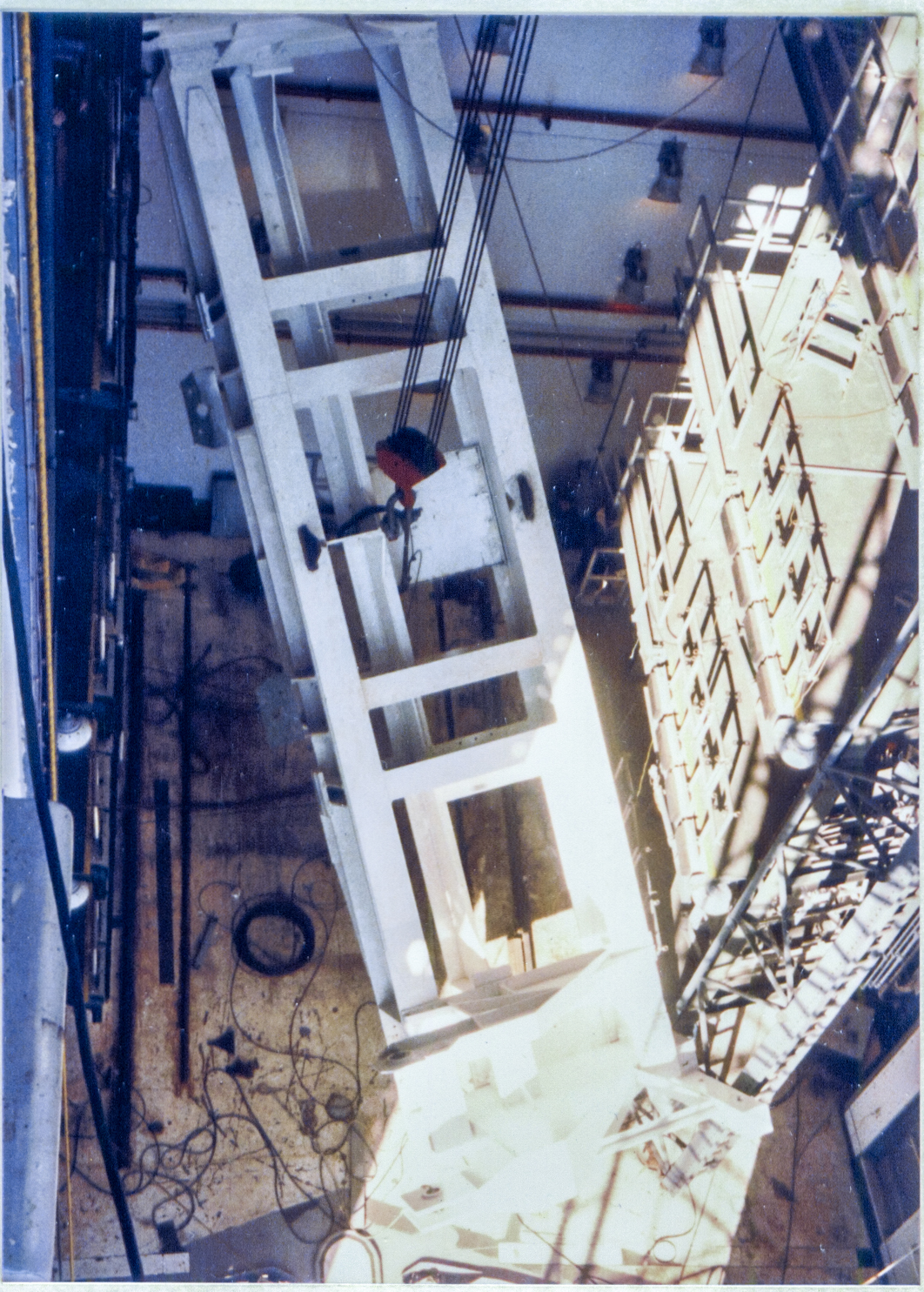
And now the main hoist line of the Manitowoc has been cut loose, and the bridge beam is now supported primarily by the load block you can see attached to it. Just out of frame to the top, the jib line is still attached, as well as such other rigging that's required to maintain the orientation and clearances required to continue going on up and in with the bridge beam.
The PCR floor (as well as all the rest of the PCR) will one day be cleaner than an operating room at the hospital, but not today. Active construction area. What a mess.
Of note, down there on that floor, you can see a couple of long, thin, near-black lines which run from near the back wall of the PCR toward the front. The one on the left is easier to find, and it is located between the dark circle of a coil of wire rope which itself is left of the bridge beam, and on the other side of our "line" is another, shorter and wider dark line sitting at a bit of a cocked angle to the one we're interested in. Over on the other side, our thin dark line is mostly obscured by the bridge beam, but you can see some of it peeking out through the gaps in the beam.
These "lines" are actually 3x3x1/4" angle-iron, laid toes-down, and welded to the PCR floor. Their job is that of guide rails, to provide a little help in keeping the PHGM on the straight and narrow as it rolls from the far back side of the PCR to the front, and then back again when it's finished doing its job. These PGHM Guide Rails carry no load of any kind, and in fact nothing whatsoever on the floor of the PCR carries any sensible load developed by the PGHM, which consists of its own massive weight in addition to the weight of the payload that's being handled, which can be as much as an additional 65,000 pounds. It's all in suspension. It's all hanging. It's all carried by the bridge beam.
Of further note, disappearing out of the bottom edge of the frame a little left of center, you can see most of the "notch" I described earlier (you're looking straight down on it from a significant height in this image) which accommodates the base of the orbiter's tail fin, as well as the merest sliver of the OMS Pod heated purge covers.
This frame was taken from outside the envelope of the PCR, and I was looking down from either inside of the RCS room, or on the platform that runs side-to-side along the front of the RSS just underneath the RCS room. Can't remember.
There's nobody around, and I've got a feeling that it's break time, and they're all taking their alloted fifteen-minute morning break.
I think I'm gonna take a break, too.
Return to 16streets.comACRONYMS LOOK-UP PAGEMaybe try to email me? |